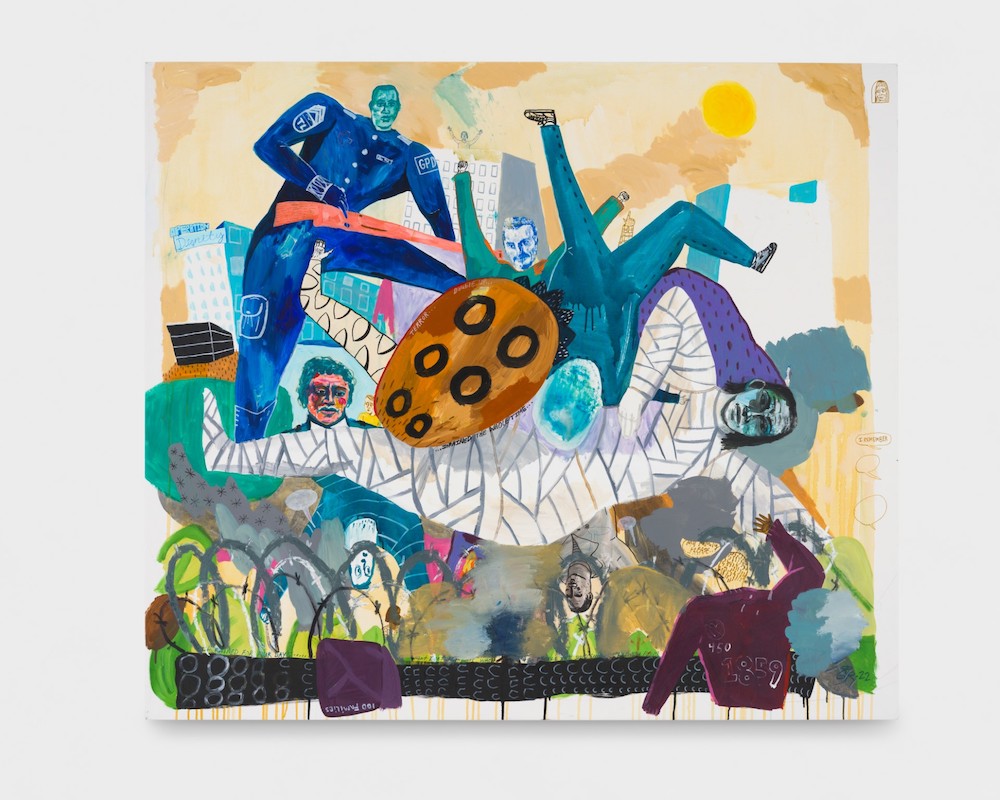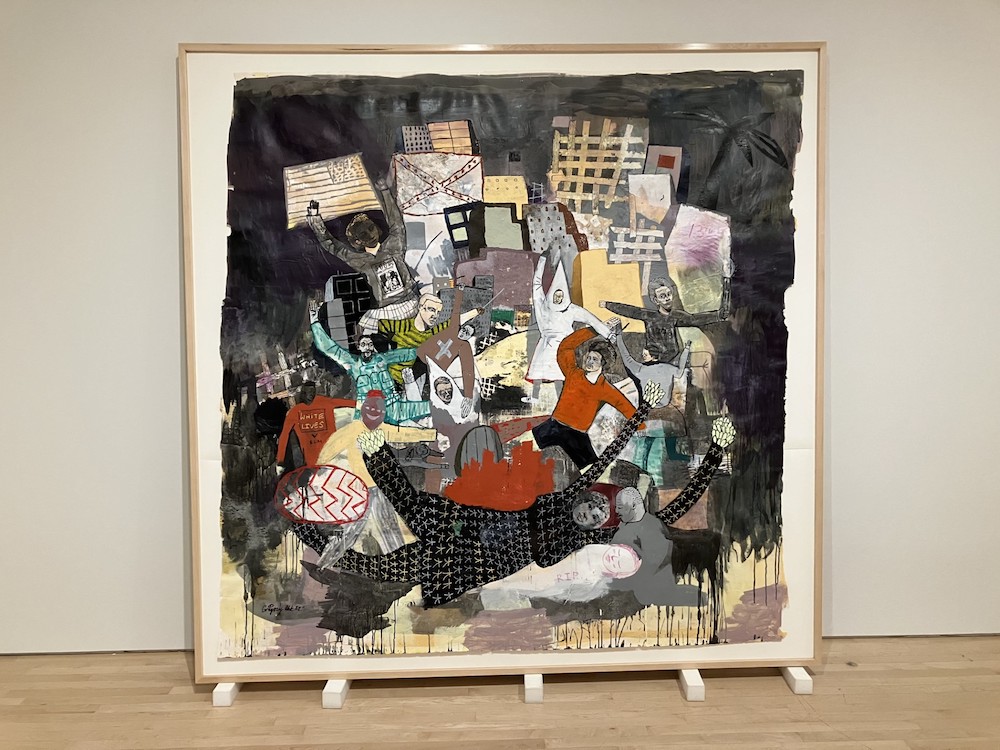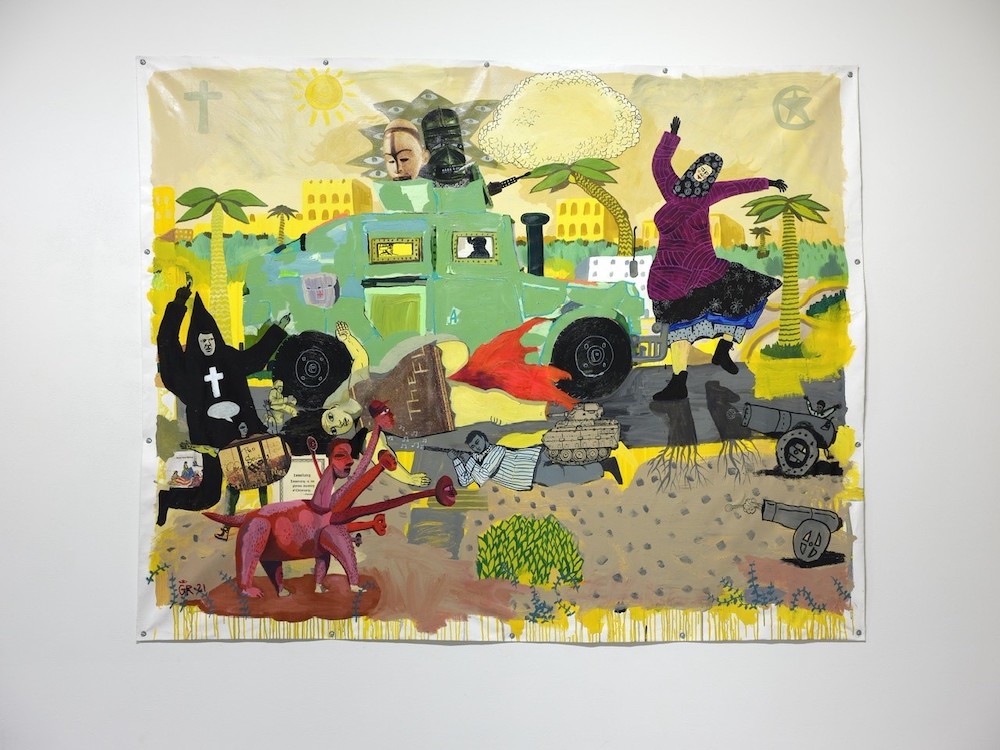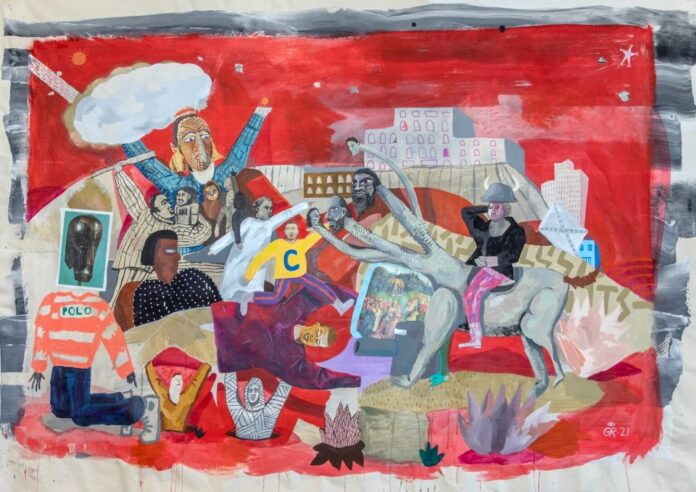Bay Area artist Gregory Rick has drawn since before he can remember. It’s how he engages with the world. His paintings represent a bent for storytelling within personal and collective, political and historical reference points. In allegorical depictions, Rick overlaps these element in works that insist we take notice and engage deeper explication.
“I have always drawn in conjunction with my historical imagination. After the army and hard times that followed, I decided to use my GI Bill to study art,” Rick told 48hills.
Rick grew up in Minneapolis, Minnesota and came to the Bay for the first time in 2001. Living in a van in the Mission with some friends, he says they “really let it all hang out” for about six months.
“I jumped in with some travelers of the punk, metal, DIY, train hopping, traveling dope fiend variety who let me roll with them from Minnesota to the Bay in their big diesel converted work van. We ‘gas canned’ the whole way,” he said.

What is gas canning? Rick explains the term refers to standing at a highway exit with a gas can and a sign and wait for the generosity of strangers. He had a pocket full of cash from working as a stagehand at a music festival but didn’t spend any of it on the journey. His crew panhandled everything and lived in the van for the two weeks it took them to travel cross-country.
In 2012, Rick returned to the Bay Area in a transitional mindset. He says he was running away from what his life had become in Minneapolis and truly believes that he would not be alive today had he not left when he did. The Bay Area resonated with Rick and continues to be his muse of sorts. He loves the history, the people, and the weather.
“There are just more of those days here where the wind is at your back. And I feel certain locations are charged by what went down there, and the Bay is definitely amongst those,” he said.
Rick completed a BFA at California College of the Arts (2019) and an MFA at Stanford University (2022) and currently resides in the Grand Lake neighborhood of Oakland. He’s maintained a studio for a few years that is a shared space, both crowded and very claustrophobic, by his estimation.
“I have to be cleaner in there with a mind to all the stuff that occupies the periphery. But usually, I will have books on hand to look through, pictures collected, found and made objects, all my paints and drawing stuff, some sculptural stuff and a lot of glues at hand,” Rick said.

As history is an important factor in Rick’s work, he’s usually plugged into a podcast or mystery story in his studio and purposely places historical artifacts and relics in his purlieu to bump into and rediscover as he works, conjuring essential narratives.
“I tell the stories of those usually left on the periphery of history and bring them to our-story painting to engage the current myth of the past critically while creating the visual myth of today,” he said.
He contemplates the dead in an effort to connect with those who have lived before us and the events from their time and place.
“I alter or emphasize certain historic seminal points, thus refighting a particular battle, remembering a certain individual, showing a failed or successful coup, thwarted assassination, the death of a heinous oppressor, a teaching session, a chance meeting a community upliftment program became moments of corrective alteration towards a more just and honest story,” Rick said.
The artist described his work as containing dissonance, simultaneously violent and peaceful.

“I engage with contemporary USA and world power dynamics in an attempt to rectify the past and tell the story of the world I was born into. As of today, Friday, the second of February, I make stories that re-engage with a victor’s history, that recount domestic and foreign policy in more equitable, nuanced ways,” he said.
Rick began winning awards early on, most notably the SECA (Society for the Encouragement of Contemporary Art) award from the San Francisco Museum of Modern Art. He was unprepared for such immediate attention at the time.
“I don’t even think I started finishing most paintings prior to this, I didn’t learn how to finish one until I was about to leave Stanford. I have—and I believe most artists have—a vision of their work in their mind that is never completely visible and is constantly developing. How successful I am has to do with trying to create this blurry thing in my mind,” he said.
Now, having been out of grad school for nearly two years, Rick is finally creating work that is aligned with his vision. He believes he is on the cusp of a breakthrough, a place he wishes he had been leading up to the SECA award. But he remains optimistic for expansion and realization of a continuity with his intention.
“I made a pledge to just paint the truth while realizing my truths are subject to change, the change is called growth. I want to paint the former and the latter. Everything has come to a head, having the time and prompts of the recent years have taught me to be more flexible with my beliefs and my work,” Rick said.
Working on multiple paintings in various sizes simultaneously (at the moment he has two medium, two large, and 25 smaller paintings going at once), Rick continues to explore the archetypes of a seemingly immutable history juxtaposed with his own present experience of the world. He hopes that viewers of his work will be stimulated to ponder this relationship as well.

“I hope the work will elicit questions first, questions about power dynamics, and ultimately the inclination that the past has something to say about now,” he said.
Through his creative work, Rick wants us to be aware of what he refers to as “the lumpen,” or the discarded stratum of society—those who have been disenfranchised from the economic class in which most of us reside. Do we attempt to render them invisible? Forget our inability to carry compassion? Will a refusal to take notice rise up to meet us when we are least expecting it? Rick references the words of UGK rapper Bun B (Bernard James Freeman) from the album Riding Dirty, as an example:
“When the poor come together the world will change. Be kind to others. Mother fuckers are sleeping on those corners that you pee on, probably cause society felt they didn’t belong.”
Greg Rick is represented by Jenkins Johnson Gallery in San Francisco. He also works with Hair + Nails, a contemporary art gallery in Minneapolis, and Beyond the Streets in Los Angeles. His most recent exhibitions include the solo exhibition, Running Wild, at Johansson Projects in Oakland and participation in the group show, Surviving the Long Wars: Unlikely Entanglements, at Hyde Park Art Center in Chicago. He will participate in Art Basel, Switzerland, from June 11-16 and has upcoming exhibitions in San Francisco, Los Angeles and New York in the works for this year.
For more information, visit his website at gregrick.com.





